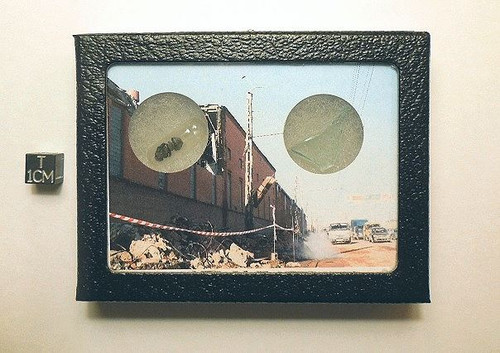This handsome display features a small sample of the Chelyabinsk meteorite encased in a removable specimen jar. The specimen is set against a color photo of the Chelyabinsk bolide (fireball) as it appeared in the sky over Russia. This display would be ideal for collecting, display, or outreach use.
On February 15, 2013, a spectacular bolide streaked across the sky over the town of Chelyabinsk. The bolide was so big and bright, that many people ran to their windows to look at it - a minute later a massive shockwave from the impact slammed the city, causing major damage. A factory wall collapsed and thousands of windows were broken by the pressure. Hundreds of people were injured by flying glass and debris.
This was the most devastating meteorite impact in Russia since Tunguska nearly a century ago. Unlike Tunguska (which was likely an icy comet), the Chelyabinsk meteorite was made of dense stone, so many fragments and meteorites survived the impact and are scattered across a large strewnfield.
Refer to the photo. The black centimeter cube is shown for scale and is not included. You are purchasing a display like the one shown. Note, your sample fragment may differ slightly in appearance from the one shown - each fragment is unique.
From the Meteoritical Bulletin entry on Chelyabinsk :
Chelyabinsk 54°49’N, 61°07’E (approximate centroid)
Chelyabinskaya oblast’, Russia
Fell: 15 Feb 2013; 3:22 UT
Classification: Ordinary chondrite (LL5)
History: At 9:22 a.m. (local time) on February 15, 2013, a bright fireball was seen by numerous residents in parts of the Kurgan, Tyumen, Ekaterinburg and Chelyabinsk districts. Images of the fireball were captured by many video cameras, especially in Chelyabinsk. Residents of the Chelyabinsk district heard the sound of a large explosion. The impact wave destroyed many windows in Chelyabinsk and surrounding cities. Many people were wounded by glass fragments. A part of the roof and a wall of a zinc plant and a stadium in Chelyabinsk were also damaged. Numerous (thousands) stones fell as a shower around Pervomaiskoe, Deputatsky and Yemanzhelinka villages ~40 km S of Chelyabinsk. The meteorite pieces were recovered and collected out of snow by local people immediately after the explosion. The snow cover was about 0.7 m deep. The falling stones formed holes surrounded by firn snow. Largest stones reached the frozen soil. A stone may have broken the ice of Chebarkul Lake, located 70 km W of Chelyabinsk. Small meteorite fragments were found around the 8 m hole in the ice but divers did not find any stones on the lake bottom.





